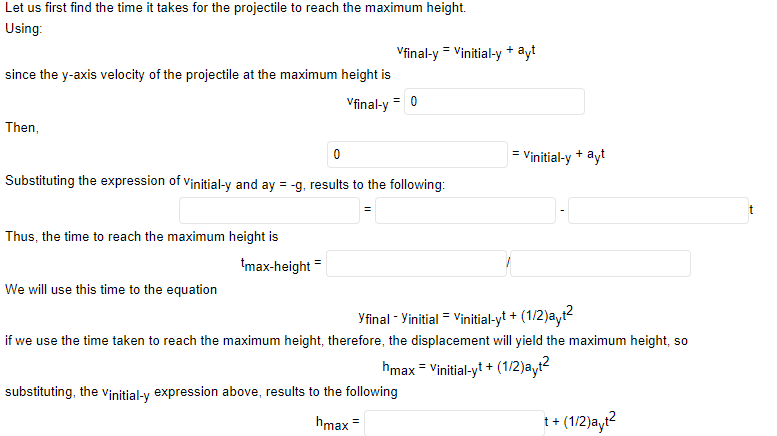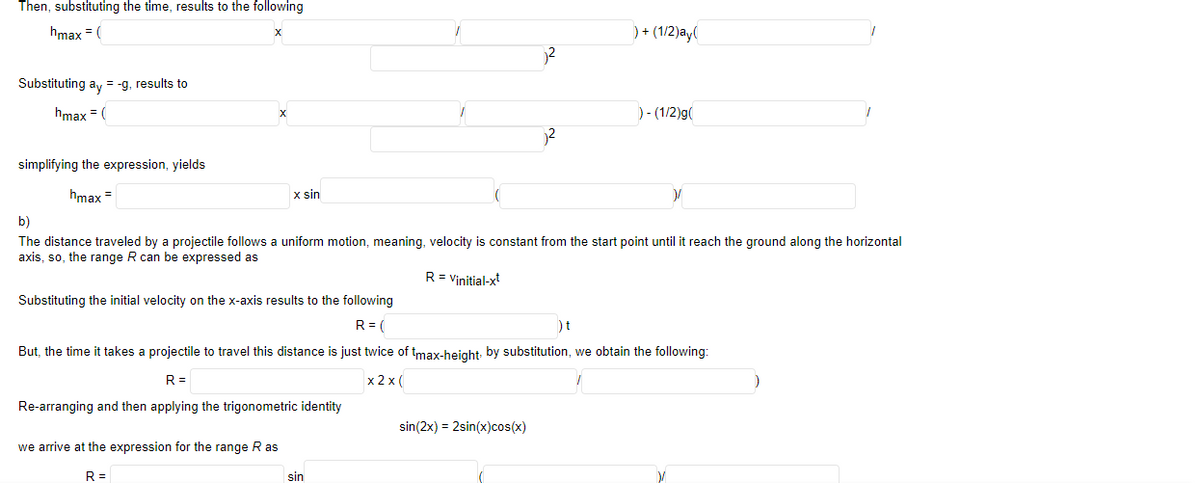Kindly fill in the blanks. For a projectile lunched with an initial velocity of v0 at an angle of θ (between 0 and 90o): a) Derive the general expression for maximum height hmax and the horizontal range R. b) For what value of θ gives the highest maximum height? The components of v0 are expressed as follows: vinitial-x = v0cos(θ) vinitial-y = v0sin(θ)
Kindly fill in the blanks. For a projectile lunched with an initial velocity of v0 at an angle of θ (between 0 and 90o): a) Derive the general expression for maximum height hmax and the horizontal range R. b) For what value of θ gives the highest maximum height? The components of v0 are expressed as follows: vinitial-x = v0cos(θ) vinitial-y = v0sin(θ)
University Physics Volume 1
18th Edition
ISBN:9781938168277
Author:William Moebs, Samuel J. Ling, Jeff Sanny
Publisher:William Moebs, Samuel J. Ling, Jeff Sanny
Chapter3: Motion Along A Straight Line
Section: Chapter Questions
Problem 113CP: The position of a particle moving along the x -axis varies with time according to x(t)=5.0t24.0t3 ....
Related questions
Question
Kindly fill in the blanks.
For a projectile lunched with an initial velocity of v0 at an angle of θ (between 0 and 90o):
a) Derive the general expression for maximum height hmax and the horizontal range R.
b) For what value of θ gives the highest maximum height?
The components of v0 are expressed as follows:
vinitial-x = v0cos(θ)
vinitial-y = v0sin(θ)

Transcribed Image Text:Let us first find the time it takes for the projectile to reach the maximum height.
Using:
Vfinal-y = Vinitial-y + ayt
since the y-axis velocity of the projectile at the maximum height is
Vfinal-y = 0
Then,
= Vinitial-y + ayt
Substituting the expression of vinitial-y and ay = -g, results to the following:
t
Thus, the time to reach the maximum height is
tmax-height =
We will use this time to the equation
Yfinal - Yinitial = Vinitial-yt + (1/2)ayt?
if we use the time taken to reach the maximum height, therefore, the displacement will yield the maximum height, so
hmax = Vinitial-yt + (1/2)ayt2
substituting, the Vinitial-y expression above, results to the following
hmax =
1+ (1/2)ayı?

Transcribed Image Text:Then, substituting the time, results to the following
hmax = (
)+ (1/2)ay(
Substituting ay = -g, results to
hmax = (
) - (1/2)g(
simplifying the expression, yields
hmax =
x sin
b)
The distance traveled by a projectile follows a uniform motion, meaning, velocity is constant from the start point until it reach the ground along the horizontal
axis, so, the range R can be expressed as
R = Vinitial-xt
Substituting the initial velocity on the x-axis results to the following
R = (
)t
But, the time it takes a projectile to travel this distance is just twice of tmax-height, by substitution, we obtain the following:
R =
x 2 x (
Re-arranging and then applying the trigonometric identity
sin(2x) = 2sin(x)cos(x)
we arrive at the expression for the range R as
R =
sin
Expert Solution
This question has been solved!
Explore an expertly crafted, step-by-step solution for a thorough understanding of key concepts.
Step by step
Solved in 2 steps with 2 images

Recommended textbooks for you

University Physics Volume 1
Physics
ISBN:
9781938168277
Author:
William Moebs, Samuel J. Ling, Jeff Sanny
Publisher:
OpenStax - Rice University

University Physics Volume 1
Physics
ISBN:
9781938168277
Author:
William Moebs, Samuel J. Ling, Jeff Sanny
Publisher:
OpenStax - Rice University